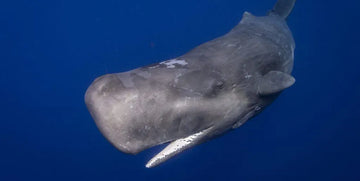The sperm whale (Physeter macrocephalus) is the largest member of the family of odontocetes or toothed whales. It is the whale that dives to greater depths to capture its food (up to 1,500 meters deep). It is capable of holding its breath for up to 90 minutes. In their dives in search of food, which are usually an average of 600 meters, there is no sunlight, so the only way to find large animals is through their developed echolocation system, which they also use to navigate.
T-shirts for Whale Lovers
SEE MORE WHALE T-SHIRTS
The sperm whale generates high frequency sounds by passing air from the bony nostrils through the phonic lips, a structure inside the head, which when bounced against the surface or animals gives it an "image" of what is around it. This system is also used to stun large marine animals such as the colossal squid, its favorite prey. When the whale has identified one of these animals, it intensifies its snapping sound, stunning the prey to make it easier for it to capture it.
The sperm whale's head is square, blunt and has a small, thin jaw that holds between 18 and 25 teeth. It is one of the cetaceans with the largest head, occupying a third of its total body length and a third of the animal's weight.
Another defining feature of sperm whales is that their dorsal fin is small. It is located close to the caudal fin, and is followed by different "knuckles" along the spine. Its fins are small and not very pointed, while its caudal fin is wide, with a distance from tip to tip of 5 meters. This size gives it the power it needs to dive to great depths.
Males reach a maximum length of 18 meters and weigh up to 48 tons. Female sperm whales are much smaller, reaching a maximum length of 11 meters and a maximum weight of 14 tons.
Although its main food source is large and medium-sized squid found beyond 400 meters, it also feeds on other species of fish, rays, octopus and sharks. A sperm whale consumes about one ton of food each day.

Show Your Love for Whales
SEE MORE WHALE SWEATSHIRTSDistribution of sperm whales
Sperm whales can be found in all the world's oceans. Males, found both singly and in groups, inhabit higher latitudes. Occasionally they migrate to lower latitudes, and only the largest adult males seem to enter the breeding grounds near the equator. Females, calves and juveniles remain in the warm tropical and subtropical waters of the Pacific, Atlantic and Indian Oceans throughout the year. Near our coasts we can see them both in the Canary Islands and in the Azores Islands, Portugal.
The sperm whale population is still quite numerous, but the selective hunting of males of reproductive age has caused the birth rate to decrease enormously. During 1965 alone, almost 30,000 of these cetaceans were killed, seriously affecting the continuity of the species. Today, it is estimated that 360,000 sperm whales populate our oceans, far below the 1.1 million that existed before the massive hunts.

























